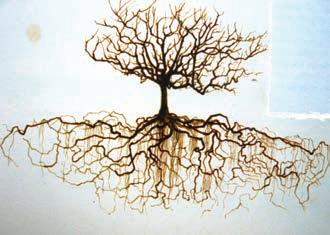INSIGHT / 07
‘TIME TO THINK LIKE A TREE?’ Terry O’Regan issues a call for urban landscapers to rethink current tree planting guidelines…
A
recent post from MEP Ciarán Cuffe of the Green Party on LinkedIn provided the stimulus for this article. It featured an urban Brussels street scene. Ciarán highlighted the low-key, unobtrusive traffic-calming measures compared to often over-engineered Irish traffic-calming measures. I wholeheartedly agree with Ciarán, but my brief comment drew attention to the miniscule planter space allocated to the 4 trees in the scene. It set me thinking, again, about the whole issue of urban trees, their roots, and a ‘1,000-word’ image. As a landscape horticulturist I have constantly faced questions about trees - how close to existing mature trees could excavations take place? What size planting hole would be needed in a 1.2m wide car-park ‘island bed’ with concrete-haunched kerbs? My throat would go dry trying to explain the needs and nature of tree roots. Daily, we fought hand-to-hand for both tree retention and new tree planting; nowadays there is a more receptive audience, albeit thanks to fears about global warming and carbon sequestration. Today I am the one asking questions about how well informed we are for what may be the ‘last stand’ for humanity. A century ago, Frederick R. Barnard, writing in the journal Printer's Ink, coined the phrase about images: "One look is worth a thousand words".
18
HC / Summer 2022
NIAB EAST MALLING
Fifty years ago, in The International Book of Trees (1973) by Hugh Johnson, I spotted a 3-inch x 2-inch image that was worth a thousand words and more for me throughout the years. It featured an apple tree unearthed by the renowned East Malling Research Station in Kent. I used it to explain tree roots to architects and engineers when they wanted to excavate in the vicinity of trees. A similar apple tree, grown on a Malling 26 rootstock, was featured at the East Malling Research Station centenary exhibit at the 2013 Chelsea Flower Show (see main image). Each of you will come across ‘1,000-word’ images that you will refer to again and again over subsequent years. Readers with any involvement with trees might store the above images. That tiny image clearly demonstrated that the spread of the tree root system is double the spread of its crown and not an underground mirror-image of the crown, as was the vague understanding of so many
construction sector professionals. I knew where the tree roots were, but the standard rule of thumb (influenced by the mirror-image myth?) for tree surveys was the ‘dripline’, which only marked the extent of the crown and the summer rainwater cascade! It was recommended that roots should not be damaged within this ‘drip-line’. It was a rough guide that did not take account of different growth habits and site conditions, and as can be seen from the Malling trees, it was well within the actual root area. The ‘drip-line’ was replaced in the late 1900s by the Root Protection Area. Here, the radius was calculated at 12 times the tree trunk diameter 1.5 ms above ground level; this was incorporated into BS 5837 (2012) – Trees in Relation to Design, Demolition and Construction. That improved the situation for trees with upright crowns, but crucially, in my experience, the radius usually only extended as far as the old ‘drip-line’ limit for wider tree canopies. Trees don’t do maths, so roots grow in any direction parallel with the soil surface in the top one metre, or less, and typically radiate out a













